Student voters
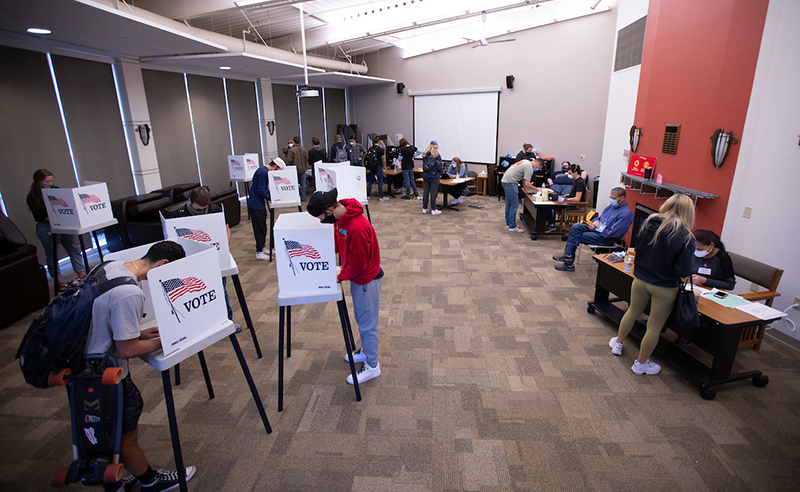
Photo by Christopher Gannon.
Iowa State students vote Tuesday in a Buchanan Hall lounge, one of four Story County polling sites on campus. According to data on the county auditor's website, student voters cast about 4,100 ballots at those poll locations.
FY20 gave first full picture of campus waste production
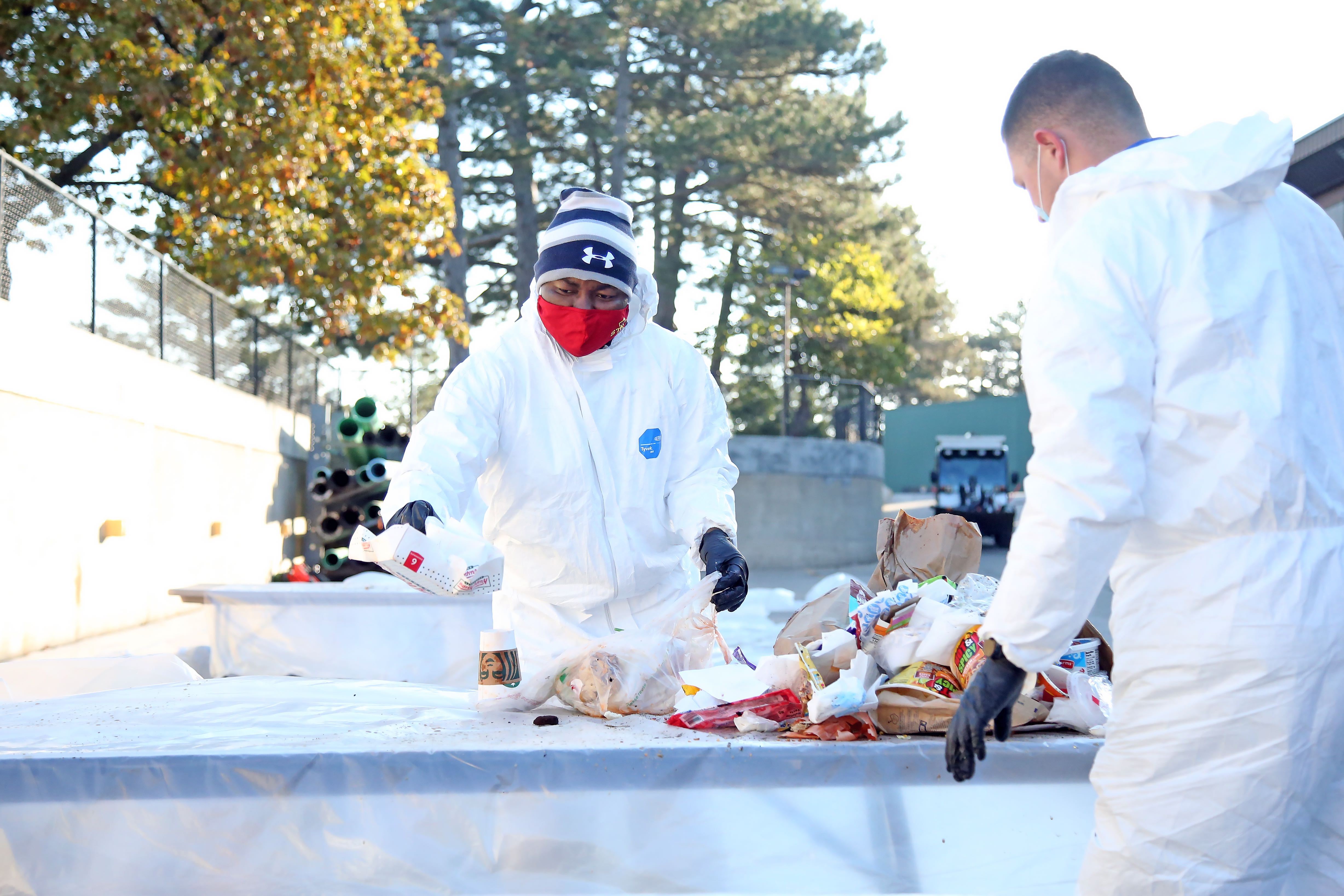
Recycling and special events coordinator Ayodeji Oluwalana sorts through trash collected in Frederiksen Court apartments during an Oct. 30 trash audit. Oluwalana and student volunteers conducted the audit to assess the impact of a food waste composting program in Frederiksen Court. Photo by Blake Lanser.
It is impossible to know how much progress Iowa State is making on its zero-waste goal to reduce landfill usage by 85% by 2025 if it isn't clear how much waste it produces in the first place.
Which makes 2020 a landmark year for recycling and special events coordinator Ayodeji Oluwalana, who oversees the university's zero-waste initiative. Due to the variety of ISU hauling contracts, fiscal year 2020 was the first time he was able to accurately determine how much waste the university generated and what happened to it -- including at athletics venues and research farms. The FY20 data will serve as the benchmark for measuring future improvements.
That's the good news. The bad news, though unsurprising? It's a pretty big number. In the fiscal year ending June 30, Iowa State produced more than 11,000 tons of solid waste, and more than one-quarter of it ended up in the landfill near Boone that serves the Ames area.
"We're sending over 3,000 tons to the landfill annually. That's a huge amount," Oluwalana said.
ISU waste production FY20
|
Destination |
Weight (tons) |
Proportion of total waste |
|
Reused/donated |
92 |
0.8% |
|
Recycled |
5,255 |
46.3% |
|
Composted |
385 |
3.4% |
|
Refuse derived fuel (Ames power plant) |
2,515 |
22.2% |
|
Landfill |
3,102 |
27.3% |
|
Total |
11,349 |
|
In fiscal year 2019 -- using approximations that didn't consider major aspects such as the athletics department and debris from construction and demolition -- Oluwalana estimated a diversion rate of about 67%. Keeping 73% of waste out of the landfill in FY20 probably represents some progress.
But without the city of Ames' Resource Recovery Plant, a waste-to-energy facility that uses burnable garbage for power plant fuel and sends the rest on to the landfill, the rate would be worse. About half of waste produced on campus was hauled away as trash, though more than 2,500 tons were burned at the recovery plant. Using trash as fuel is better than dumping it in the landfill, but it's on the lowest tier of the U.S. Environmental Protection Agency's waste management hierarchy, which prefers reuse and reduction above all.
"Ultimately, the goal isn't to manage waste but eliminate it," Oluwalana said. "If we can control what we generate, we don't have to focus on recycling."
Q&A set for Nov. 13
To celebrate America Recycles Day, a virtual Q&A will be held Nov. 13 (1-2:15 p.m.). ISU employees and students involved in sustainability work will discuss the state of campus recycling efforts.
Of the more than 5,200 tons recycled in FY20, plastic, paper and metal collected in single-stream bins and the separate cardboard recycling program together accounted for only about 7%. About 86% was recycled construction and demolition materials.
Influential data
In addition to setting a baseline for future years, accurate statistics are helpful as Oluwalana seeks to partner with departments and units on waste reduction. It allows analysis based on budget savings, an effective attention-getter. Recycling, reusing and composting materials saved the university about $544,300 in landfill disposal fees in FY20, for instance.
"People react to data," he said. "When they understand the financial implications, I think they're more likely to buy in."
President Wendy Wintersteen's approval of a five-year sustainability plan also will help drive interest in waste-reduction efforts, Oluwalana said.
Departments and units can request a presentation on waste reduction by emailing recycling@iastate.edu.
So far this year
Cleaning and safety protocols necessary during the pandemic tend to increase trash, but in the first quarter of FY21, July through September, overall ISU garbage production is down. However, Oluwalana said, waste hasn't decreased as sharply as campus density.
"With less people, we shouldn't be generating this amount," he said.
In July 2019, ISU produced 193 tons of trash either burned at the Ames power plant or shipped to the landfill, compared to 173 tons in 2020. In August 2019, 214 tons were hauled away as trash, compared to 207 in 2020. With the return of students in September, the difference was more noticeable, with 324 tons in 2019 and 243 in 2020.
Earlier this fall, Oluwalana shared some ideas on how to limit waste production during the pandemic.
Freddy Court composting
Custodial service changes caused by the pandemic have paused some of the initiatives Oluwalana hopes to expand to boost recycling rates on campus, including a plan to make recycling bins the only option for at-desk disposal bins in office spaces.
One new program that launched in the past year is a composting service for food waste in the Frederiksen Court apartments. Organized by the Engineers for a Sustainable World student club, the program began last fall after a six-week pilot in spring 2019. Oluwalana said he's working with students to expand the composting option to other university apartments and to make sure the push for composting continues even after the students involved graduate.
"We've started talking about a succession plan," he said.
Lab school pivots to help working families
Kids Club update
The YSS Kids Club, which has four classrooms on the first floor of Ross Hall, is still accepting elementary-age children into its program. The program helps children with their required online schoolwork and provides virtual learning support to those who choose to distance learn.
It is an email Jennifer Van Ryswyk plans to save.
The director of the Child Development Laboratory School knew the pandemic was putting significant strain on parents of school-age children trying to balance jobs with their children's virtual learning.
Van Ryswyk and university leaders decided to expand the lab school's offerings to provide educational instruction to children in kindergarten through third grade while the Ames Community School District (ACSD) conducts hybrid and online classes in response to the coronavirus. That is in addition to the programs for infants, toddlers and preschoolers the lab school already provides.
"One family that is enrolled made a comment in an email, 'If you didn't make this opportunity available to me, I was considering quitting my job to stay at home and educate my kids,'" Van Ryswyk said. "The goal of this is to be able to support families."
Filling a need
There are 13 school-age children at the lab school, four of whom are set to return to ACSD in-person instruction this month. To mitigate the chance of spreading the coronavirus, no more children will be added.
"This is temporary, not permanent," Van Ryswyk said of expanding instruction to older students. "We are taking our cues from the Ames school district. It could be that this program ends the first day of spring semester, it could end in May. After that we will reevaluate, but we won't do a summer program."
The program was offered to the Iowa State and Ames communities through a pair of emails. The first went to previous lab school participants and another to a listserv of people at the university interested in helping parents, supported by university human resources program specialists Cris Broshar and Julia Graden. Consistent with the lab school's process, families were selected through a lottery.
The children attend weekdays from 8 a.m. to 4:30 p.m., and the teachers give them as much of a school environment as possible. Children learn through online instruction and packets provided by the ACSD. Lab school teachers supplement the instruction and help children complete their homework, taking that burden off working parents.
"Our kindergarteners are learning how to be school-agers, and our third graders are fairly tech-savvy," Van Ryswyk said.
The children's temperatures are checked to begin the day and again before going home. There have been no coronavirus cases reported. Cyclones Care measures like hand-washing and physical distancing are observed.
Making it happen
Van Ryswyk said the lab school was able to expand its offerings when enrollment dropped this fall. Some parents didn't send their young children to the lab school either because they are working from home or don't feel comfortable doing so during the pandemic.
"When we looked at the numbers we realized we had this space we did not think we would have," Van Ryswyk said. "We were already hearing from parents and friends of school-age children who were just stressed out."
There was plenty of work that needed to be done before classes began for the older children, but modifying the space was not part of it. The temporary program is located in the Palmer Human Development and Family Services Building in a space that previously was a public school kindergarten and intended for a school-age program.
"We didn't have to do anything to the space. The desks and chairs were already the right height," Van Ryswyk said.
The school has 10 teachers and four classrooms -- for infants/toddlers, 2-year-olds, preschool/prekindergarteners and school-age children. Two licensed teachers work with the older children. The mission of the lab school is to provide Iowa State students with hands-on experience working with and observing young children, but ISU students and parents are not allowed in the classrooms during the pandemic.
Gerdin Building addition opens this month
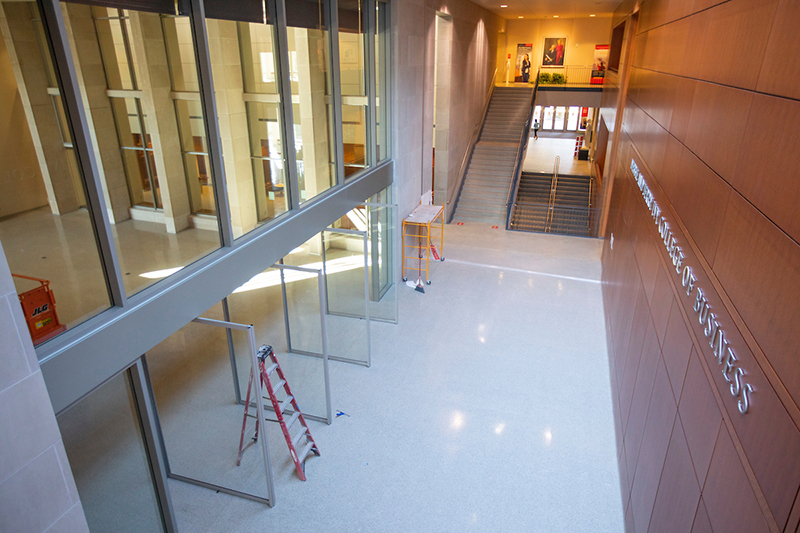
The Kingland Hub (left), a commons area available for student studying and special events, is one of the central features in the Gerdin Business Building addition. The scaffolding (center) is about where the new space joins the original building, visible at the top of the photo. Photos by Christopher Gannon.
Construction on a four-story, 45,000 square-foot east addition to the Gerdin Business Building, which started in February 2019, is scheduled to be completed by the end of this month. Crews are taking care of final details in electrical, information technology and furniture, and the Gerdin custodial team is getting the new spaces ready this week for the college's Business Week Nov. 9-12.
The $28 million addition enlarges the building by 40% and was designed with students in mind. It includes five classrooms, five team rooms for student collaborations, a central commons area known as the Kingland Hub and a state-of-the-art Houston professional sales suite, a hallmark of a new marketing department program that provides space and technology for sales education and practice. The addition also adds 35 faculty offices, and the process of returning Ivy faculty and staff from temporary offices on the Memorial Union fourth floor will begin later this month.
Students will start using the new team rooms and Kingland Hub this month, and spring semester courses are scheduled in the classrooms. Adjacent to the Gerdin Building, Wallace Road is scheduled to open Thursday morning, Nov. 5.
More than $18 million in private gifts helped fund the expansion, including a $7 million commitment from the Gerdin Charitable Foundation. College ($9 million) and university ($1 million) funds covered the remainder.
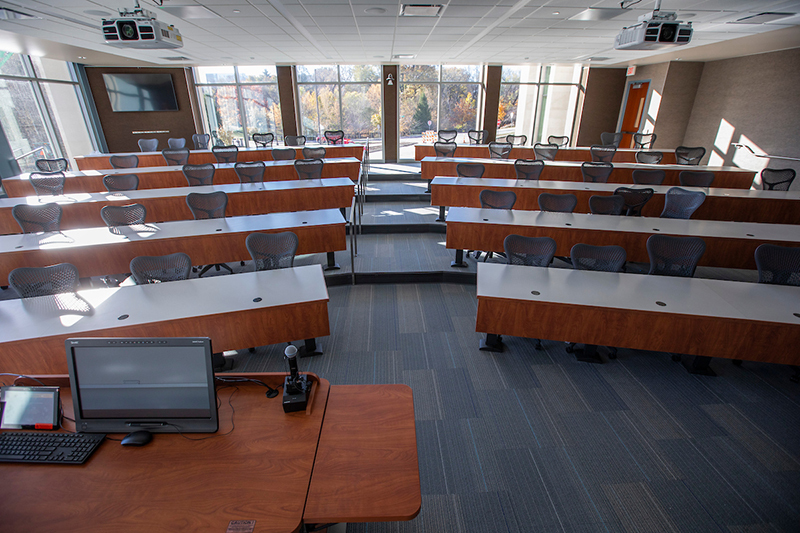
The Heiden Family classroom in the Gerdin addition features a tiered floor, instructional technologies and daylight.
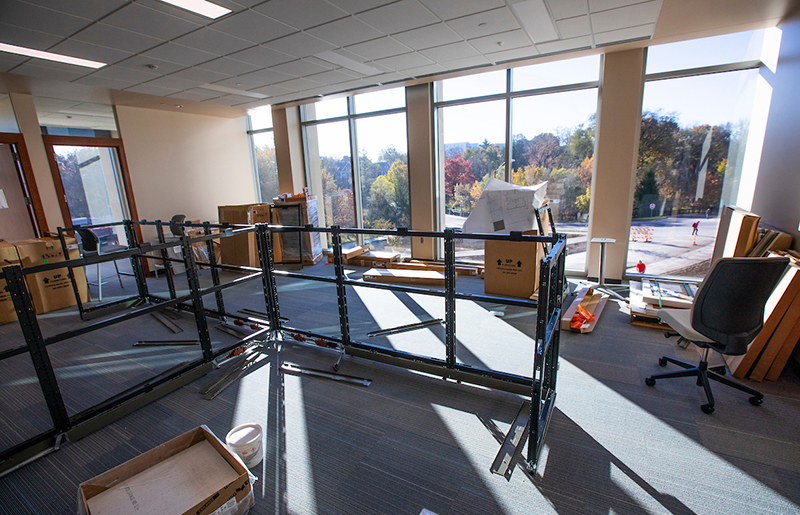
Furniture installation should wrap up this week in the Gerdin Building addition.
Awards recognize exemplary employee, graduate student efforts in a pandemic
Get writing, Iowa Staters. Here's your chance to recognize and thank that person or team whose pandemic response you've so admired. In an Oct. 30 memo to the university community, President Wendy Wintersteen announced a set of COVID-19 Exceptional Effort Awards to recognize the innovative ways employees, including graduate students, "have strived to overcome the challenges of the pandemic."
Simple nominations of up to 500 words -- and absent supplementary documents -- are due by the last day of fall classes, Friday, Nov. 20. Nominators should use the form on the awards website. Recipients will be notified by Dec. 16.
Individual recipients will receive a certificate, campus recognition and a $500 stipend. Units or teams selected for an award will receive a certificate, campus recognition and a monetary award to support a unit or team's priority need. The award stipends are made possible by private donations in support of the university.
A dozen options
Wintersteen said the 12 award categories intentionally are broad so that individuals, teams, entire units or inter-unit collaborations qualify for them. Short descriptions are on the awards website. Up to three winners may be selected in most categories, with the exception of exemplary team or unit effort, which is capped at five awards. Awards will recognize:
- Excellence in face-to-face instruction
- Excellence in remote instruction
- Graduate student teaching impact
- Excellence in instructional support
- Research impact
- Graduate student research impact
- Extension impact
- Principles of Community champion
- Exemplary team or unit effort
- Exemplary operational support
- Exemplary student support
- University Hero
Nominating, nominees
All faculty, staff and graduate students are both eligible for an award and may submit a nomination. "All" includes those with part-time appointments, employees in emergency or temporary status and faculty at any rank. Wintersteen said the goal is that the university's four divisions all receive recognition through this program, and a central committee that reviews nominations will strive for that balance.
Questions about the nomination process may be directed to Megan Peterson in the provost's office, 294-6410.
Report details service delivery's first year and future plans
In the first year of the improved service delivery (ISD) model, an average finance specialist processed 4,924 transactions on Workday and responded to 708 requests submitted through ServiceNow. Human resources specialists averaged 354 Workday transactions and 180 service tickets.
The service team workload statistics come from the ISD advisory committee's fiscal year 2020 report, which details performance indicators, successes, challenges and future plans for the initiative that launched in July 2019 in tandem with the Workday enterprise platform. ISD shifted most finance and HR work from local departments to centralized teams of specialists.
The advisory committee supports and assesses the ISD service teams, soliciting feedback from campus partners and promoting a culture of continuous improvement. Its first annual report, released Nov. 2, covers the fiscal year ending June 30. Here are some of the report's highlights:
Workload and efficiency
It took finance specialists an average of seven days to resolve a Workday transaction and less than one day to resolve a ServiceNow incident. For HR specialists, the average Workday transaction took two days to complete, while service requests took about a day and a half.
The differences in resolution times and the quantity of transactions and requests handled vary between HR and finance because the nature of the work is different, the report noted. For instance, about one-third of finance team Workday transactions were effort certifications or P-card verifications -- which require a customer approval to complete. If those transactions are excluded, financial transactions took on average two days to complete. HR work, on the other hand, involves more personal interaction and often is more complex.
Both groups reported quicker turnaround on a common task. Finance teams reduced the time to clear unverified P-card transactions by 36%, while HR service teams helped reduce the time it took to hire staff by 47% for professional and scientific positions and 30% for merit.
Benefits and satisfaction
The new structure was designed to provide units more consistent and proficient service, while improving workload balance, collaboration and room for advancement for HR and finance staff.
In responses to customer satisfaction surveys, 88% of employees who worked with a finance specialist said they were satisfied with the service they received and 95% said their concern was accurately addressed. Surveys found 80% of respondents were satisfied with the service they received from an HR specialist, and 92% said their concern was accurately addressed.
Satisfaction surveys of ISD employees will be conducted in the upcoming year. Voluntary turnover and attrition in FY20 was 19% in finance and 21% for HR teams.
Thanks to the switch to cloud-based, anytime platforms in Workday and ServiceNow, ISD staff easily transitioned to working remotely when COVID-19 struck. A survey of finance specialists found that 96% would be interested in continuing to work remotely and 85% would be interested in a hybrid environment.
Staffing and budget
Finance service teams initially were launched with a budget for 129 positions, while an HR model featured 53 positions. Primarily through attrition, finance teams have reduced their head count to 120 employees. HR eliminated two vacant ISD positions. Open positions helped pay for unbudgeted operating expenses.
The ISD initiative was expected to be cost neutral for the university, despite added upfront costs, but it's difficult to make comparisons because employee roles have changed so much.
"The ISD Advisory Committee recognizes some units have seen increased costs as they, for example, backfilled positions or made positions for remaining staff whole. Over time, we believe units will recognize efficiencies that will bring them and the university closer to cost neutral," the report stated.
Future plans
After the initial rollout of ISD and Workday, many unit leaders and faculty, in particular, had concerns about the administrative tasks Workday requires and the personal interaction lost when HR and finance staff moved to the ISD structure. HR and finance leaders responded with adjustments such as additional support and outreach. The report identified additional areas for improvement planned in the coming year.
In HR, those plans include establishing performance baselines and service level agreements, optimizing non-ISD roles (job management support, graduate assistant support, timekeeper) and supporting further Workday adoption, such as using the notification and delegation features.
In finance, two FY21 initiatives already are underway: developing custom financial reports for faculty and shifting finance job aids to the ServiceNow knowledge base. Finance ISD also aims to collaborate more closely with non-ISD staff with finance roles in Workday, such as business unit managers and cost center managers.
Mesonet provides information for research, forecasts
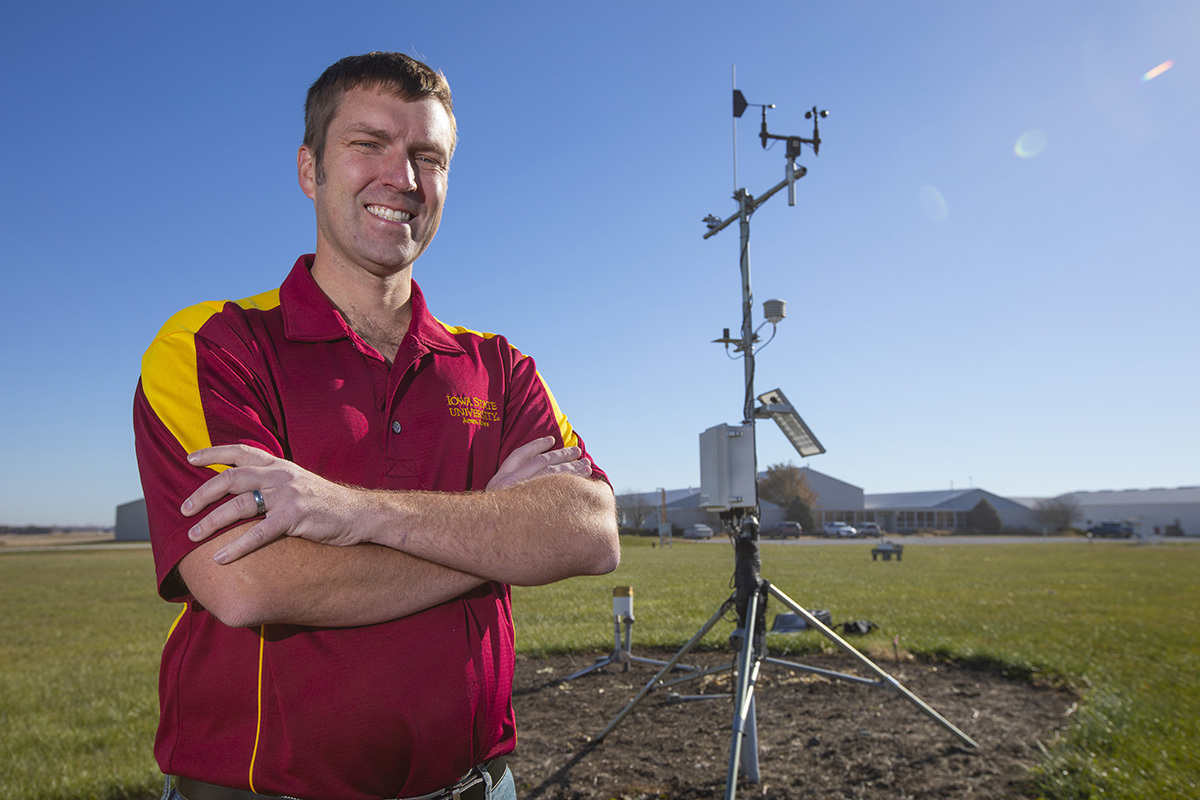
Daryl Herzmann uses weather data equipment like that on the Ag Engineering/Agronomy Research Farm to collect and archive large amounts of information for the Iowa Environmental Mesonet. Photo by Christopher Gannon.
Daryl Herzmann grew up on a dairy farm in northeast Iowa, and like most farmers, his days revolved around the weather.
"I was always frustrated by the forecast because we based our farming decisions on a two- or three-day forecast," the agronomy systems analyst said. "I decided I had to go to Iowa State and try to figure out how to fix this. That's where it dawned on me that it is not necessarily fixable, but it is a data problem."
The meteorology major began working with the Iowa Environmental Mesonet soon after graduation in 2001, providing better data to improve forecasts.
"Dennis Todey was an associate professor in agronomy at Iowa State at the time, and he was lining up funding for the mesonet when I was about to graduate," Herzmann said.
All the data is sent to servers in Durham Center where Herzmann analyzes and archives the information. The wide range of meteorological information is free to anyone, but Herzmann's skill in dealing with the vast amounts of data generated daily proves vital for researchers at Iowa State.
"I am written into a lot of grant requests by faculty who use this data in their projects," he said.
What is a mesonet?
First, let's get technical. A mesonet is a network of automated weather stations that observe, measure and track mesoscale meteorological phenomena.
Herzmann can make it more understandable for the non-meteorologists among us.
"The amount of rainfall you get compared to your neighbor's house might be different, and weather varies on scales whether it is a neighborhood, city or state," he said. "The mesoscale is meant to define scales on the order of tens of miles. Our network tries to understand weather phenomena on the scale of counties."
Herzmann's three primary sources for data collection are the Iowa State Soil Moisture Network -- with stations mostly located on the ISU research and demonstration farms -- the Iowa Department of Transportation (DOT) and the National Weather Service/Federal Aviation Administration.
The Soil Moisture Network has about 25 stations collecting data supplemented by the other two. Herzmann uses between 300 and 500 stations -- many recording different data from rainfall, temperature and wind -- to generate user-friendly products for the information coming in 24/7.
Mesonets are not rare -- nearly every state's land-grant university has one -- but the funding model for each varies. Herzmann runs the Iowa Environmental Mesonet through grant money by supplying his data to projects across the campus, usually for a few months at a time.
"We have researchers who are doing modeling and others doing field research, and they need someone to provide them with weather and forecast information in formats and products that make it easy for them to use," he said. "It is difficult to go on the internet and find some of this, but researchers also don't want to fund someone to do this full time. I come in there and am written into grants and provide that support for a month or two."
What is it used for?
Herzmann primarily focuses on precipitation and solar radiation data.
"There are very few stations that measure solar radiation data, basically the energy coming from the sun and hitting the ground," he said. "It turns out for many research applications that are done at Iowa State, solar radiation is an extremely critical value to understand and properly observe to drive things like modeling and analysis."
The data Herzmann collects aids those at the research farms in understanding their crop experiments. For example, after harvesting a corn plot, researchers can go back and look at rainfall, temperature and solar radiation to explain yield.
Research
Herzmann typically is involved in four to six projects at a time connected with the university, largely in agronomy, wind energy and computer science.
Currently, he is assisting agronomy associate professor Sotirios Archontoulis with research into crop modeling.
"He uses weather data and short-term forecasts to predict soil conditions and crop yields over the Corn Belt," Herzmann said. "I provide weather and forecast information for this modeling group to process every day."
Another big project Herzmann supports is the daily erosion project under the supervision of professor Richard Cruse with the Water Resources Research Institute. It focuses on near real-time soil loss on hill slopes in Iowa and beyond.
Consistent users
Herzmann makes all data open to the public, and its users vary from researchers to television stations.
"One of the most consistent users of this data is the entities that we are partnering with for their data," he said. "The National Weather Service is a heavy user of my website even though they already have most of the data. I just present it in a better and more useful way."
The DOT, agronomists at co-ops, companies and ISU Extension and Outreach also use the information.
Herzmann updates the website daily, finding a hook for users based on the weather. That includes snow amounts received across the state last week and recorded wind speeds during this summer's derecho.
"We observed a 92 mph wind gust near the surface from the derecho," he said.
ISU Theatre stages whimsical online production
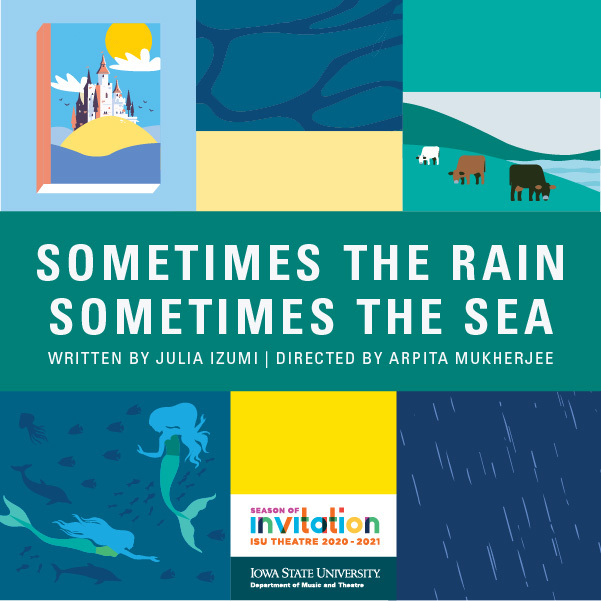
What happens when a little rain cloud falls in love with a human? Find out during ISU Theatre's "Sometimes the Rain, Sometimes the Sea," a fast-moving, whimsical play that grapples with what it means to be young, fall in love and believe in fairy tales. Enjoy a live Zoom performance of the play Nov. 6 and 7 at 7:30 p.m., or a prerecorded production available Nov. 13-19.
"This play is like that book you read as a kid and can't put down," said Mackenzie Bodell, freshman in performing arts. "It's complex and entertaining, filled with deeper themes and so many opportunities for critical thinking. It's such a creative play that bringing it to life is a rewarding experience."
Cast members said the play, written by playwright Julia Izumi, evokes the warm feelings of a bedtime story or the coziness of sitting next to a window on a rainy day. Arpita Mukherjee, artistic director of the New York-based Hypokrit Theatre Company, is guest directing the production as the College of Liberal Arts and Sciences Dean's artist-in-residence.
"This play is like walking down an unknown path and not knowing quite what is in store for you, and then being pleasantly surprised about what you find," said Kaitlyn Meylor, sophomore in performing arts. "It's truly unlike any other play I have been a part of or seen, and that excites me. I hope it inspires audiences to think about the vastness of their own imaginations."
ISU Theatre students also are studying the play as part of their fall course curriculum. Along with the live and recorded performances, students will share a curated virtual celebration of their in-class projects. The play and collaborations are part of ISU Theatre's 2020-21 "Season of Invitation," which seeks to create new and innovative pathways of performance during the COVID-19 pandemic.
Links to the live Zoom performances and recorded production will be posted on the show's production page. Admission is "pay what you will."
